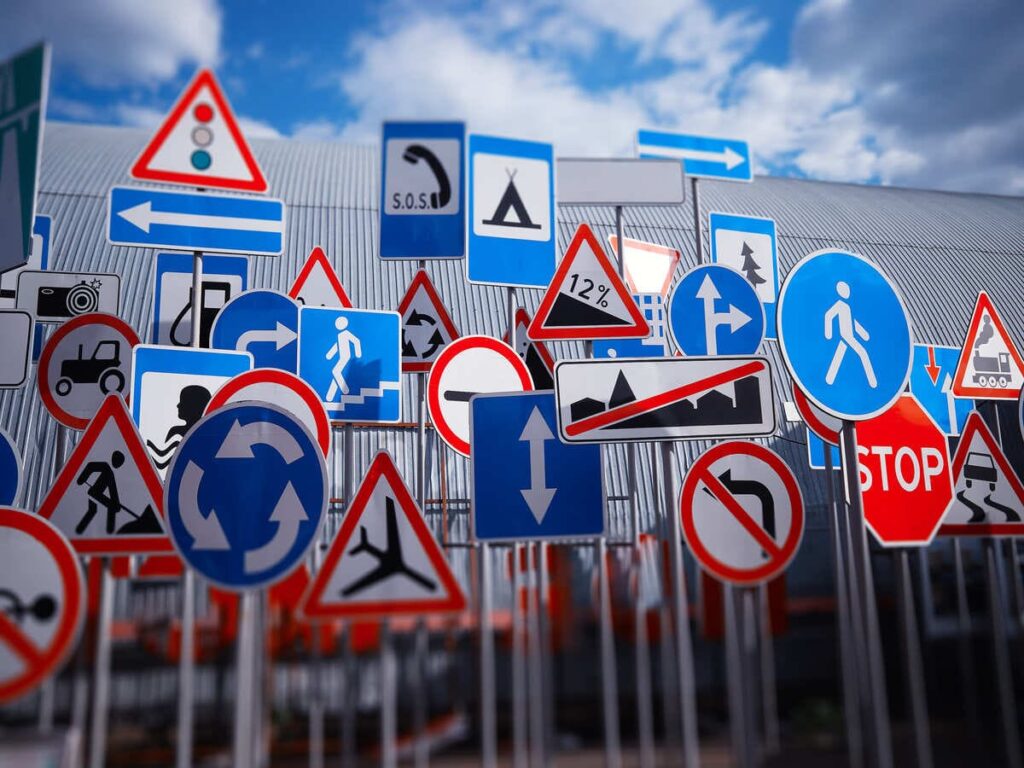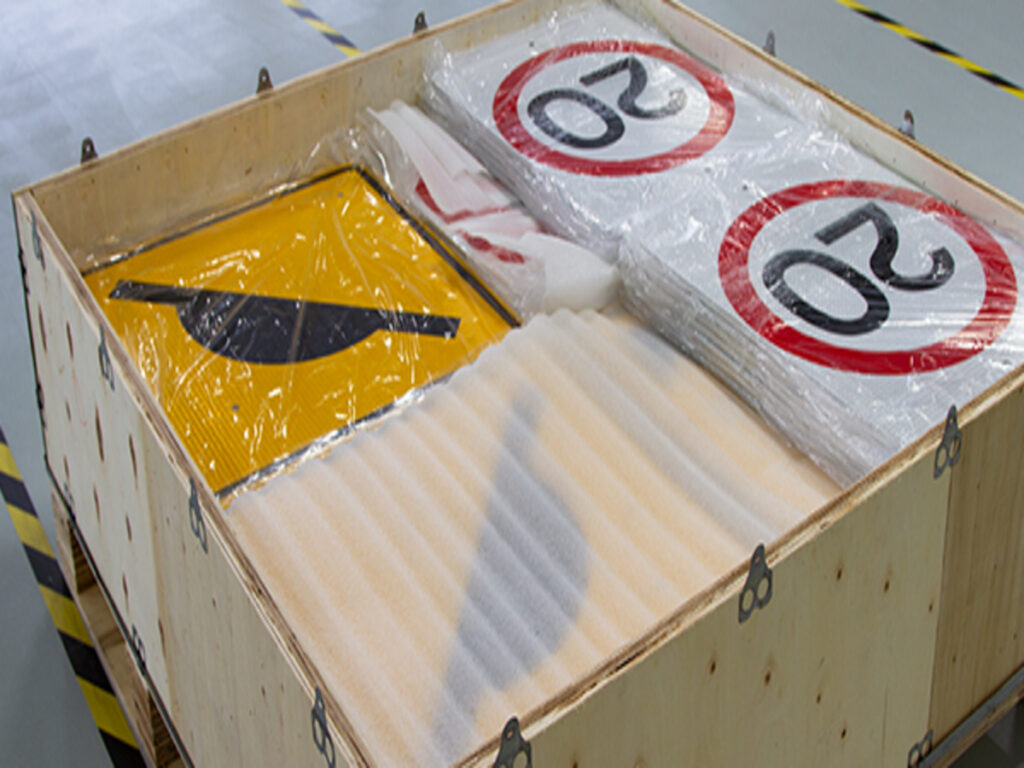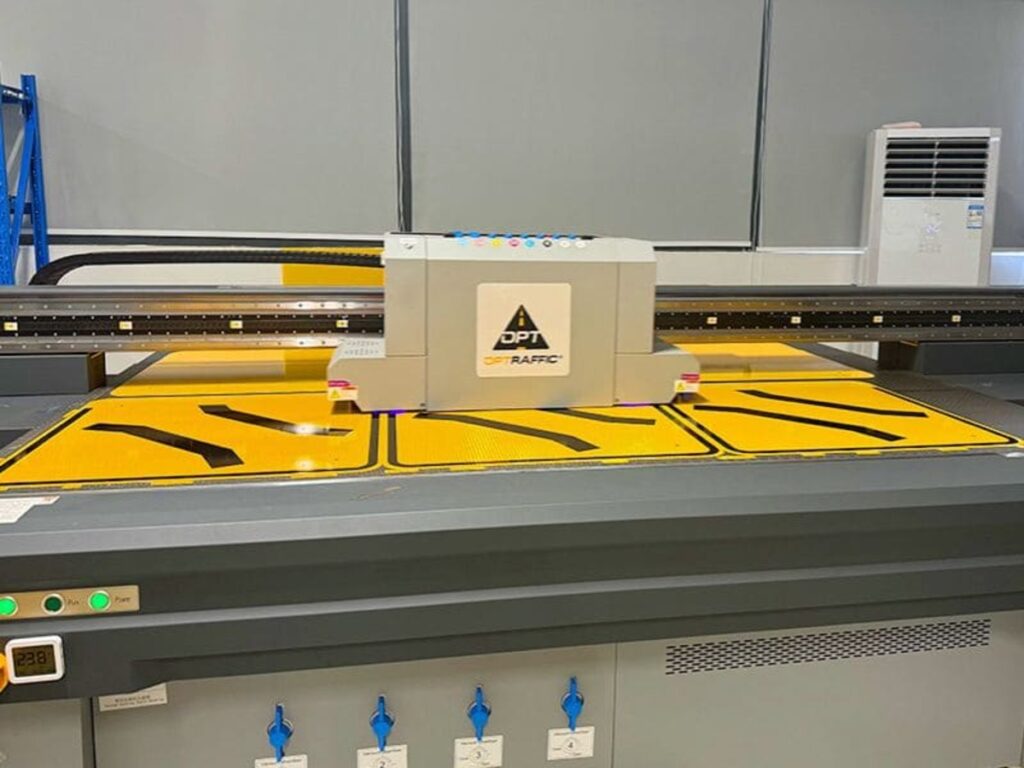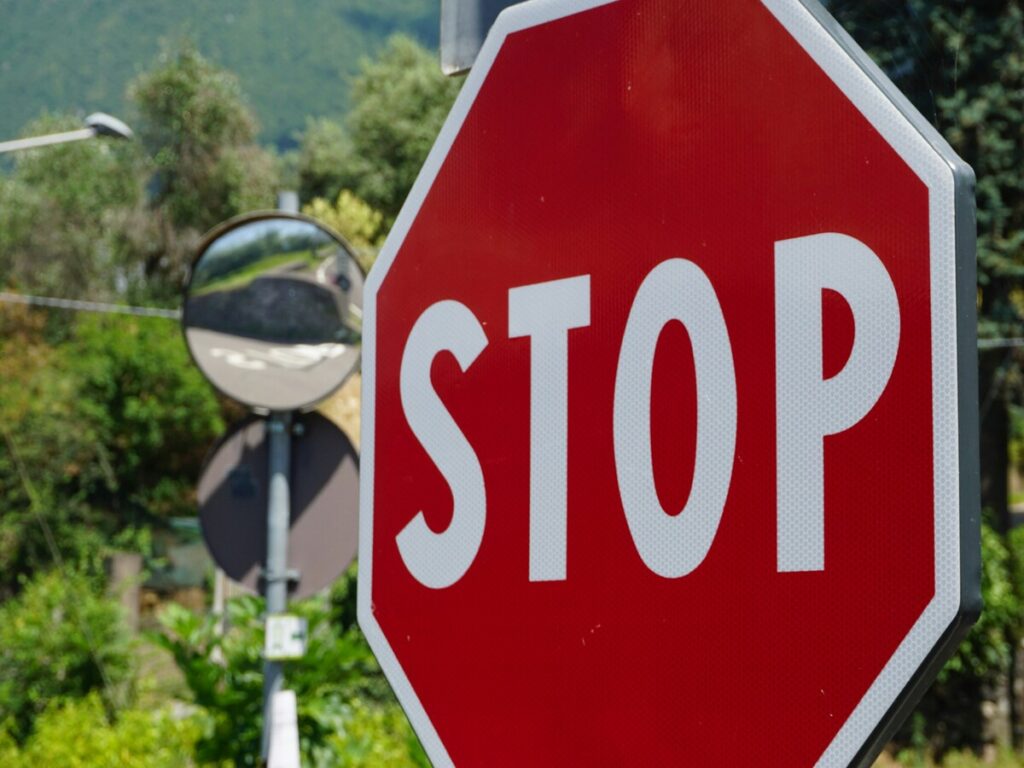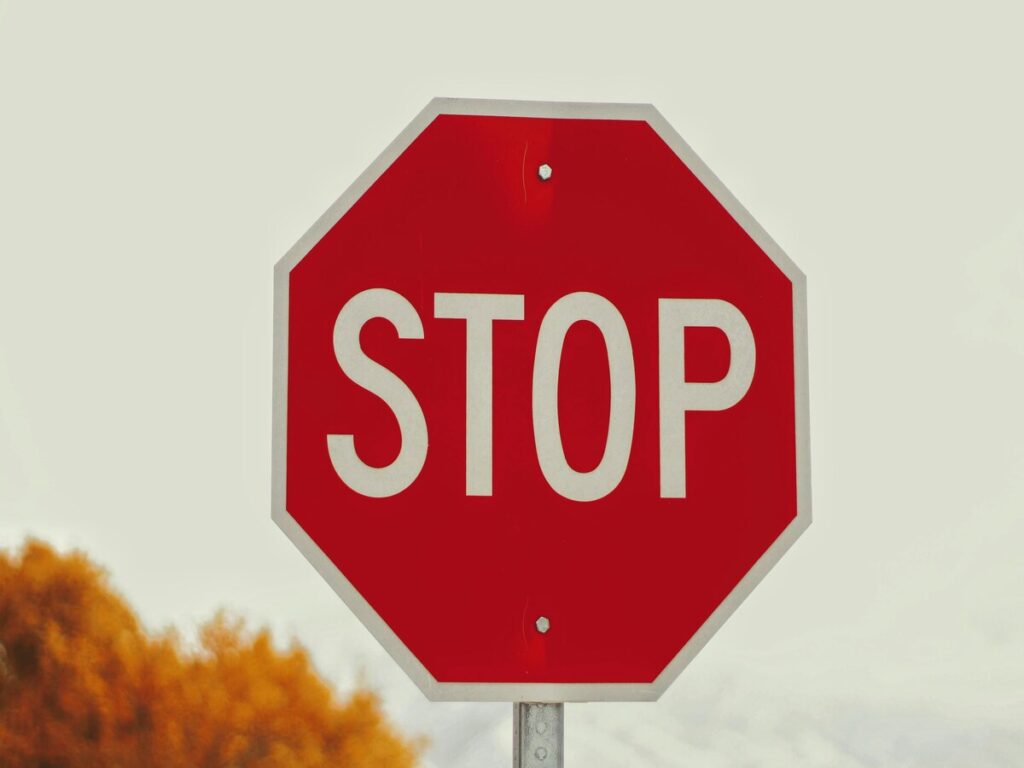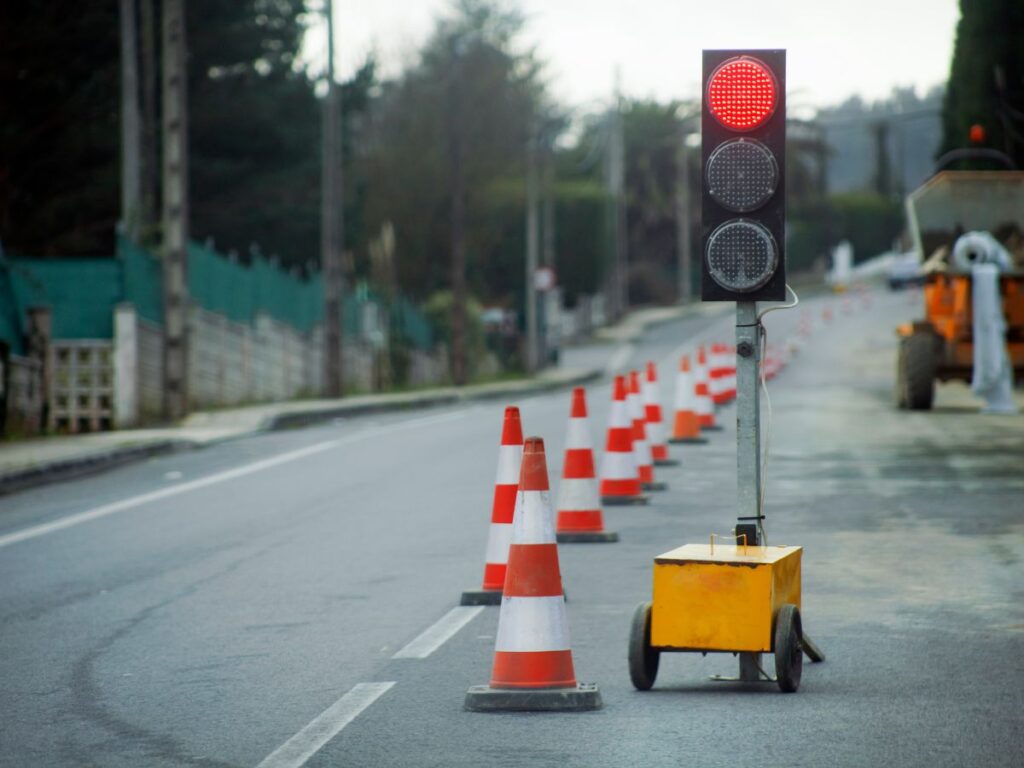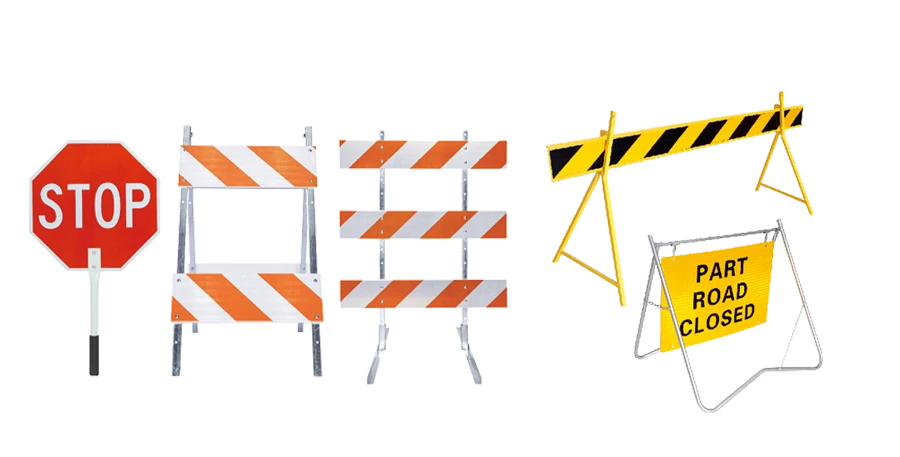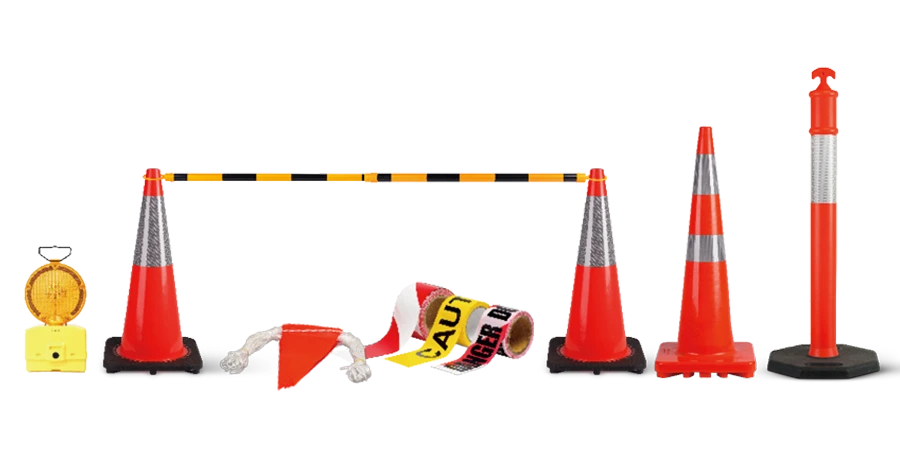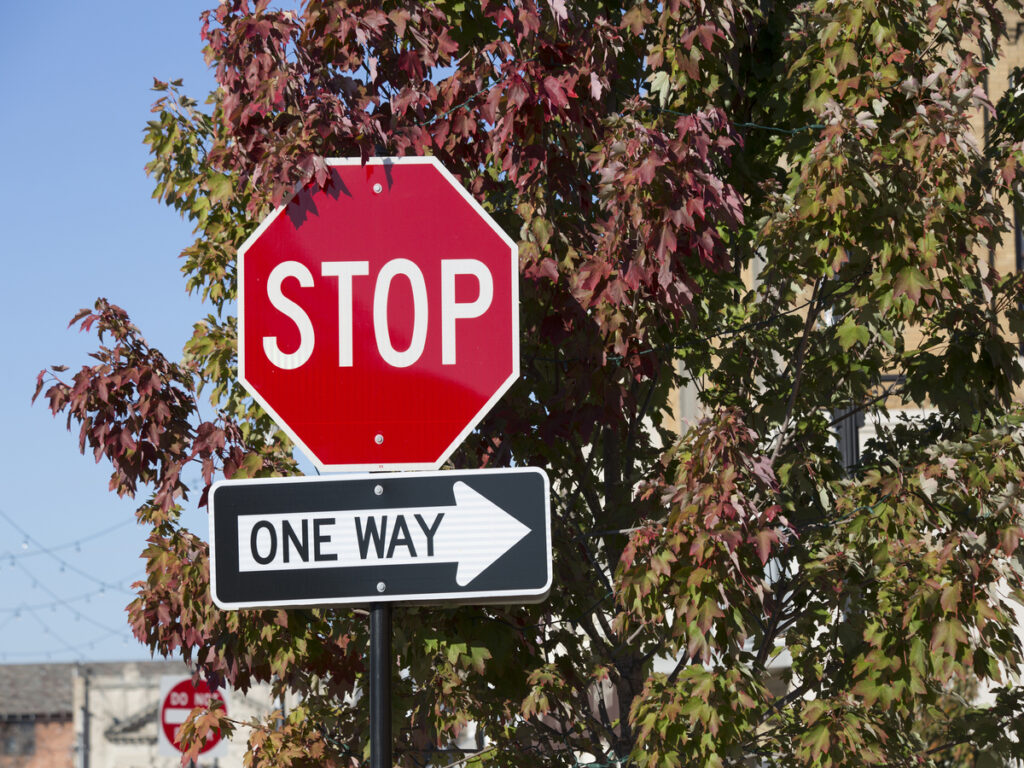
MUTCD ट्रैफ़िक संकेत सड़कों को सुरक्षित और समझने में आसान रखने में मदद करते हैं. सभी राज्य किसी तरह से MUTCD का उपयोग करते हैं, लेकिन कई के पास अतिरिक्त नियम या जरूरतें हैं. उदाहरण के लिए:
- 18 राज्य बिना किसी बदलाव के राष्ट्रीय MUTCD का उपयोग करते हैं.
- 22 राज्य अमेरिका, अधिक डी.सी.. और प्यूर्टो रिको, अतिरिक्त नियम जोड़ें.
- 10 राज्य अपने स्वयं के संस्करण बनाते हैं जो अभी भी MUTCD का पालन करते हैं.
एक ठेकेदार जो विभिन्न राज्यों में संकेत देता है, विशेष समस्याओं का सामना करता है. संघीय और राज्य दोनों नियमों को जानना गलतियों को रोकता है, लोगों को सुरक्षित रखता है, और जुर्माना से बचकर पैसे बचाता है.
राज्य लाइनों में काम करने पर ऑप्ट्रैफ़िक चुनौतियों का सामना करता है जब ठेकेदारों का सामना करना पड़ता है. की हमारी व्यापक रेंज यातायात संकेत संघीय और राज्य दोनों नियमों के अनुरूप है, यह सुनिश्चित करना कि आपकी परियोजनाएं सभी सुरक्षा और कानूनी आवश्यकताओं को पूरा करती हैं. हमारे विश्वसनीय और बहुमुखी साइनेज समाधान के साथ, आप महंगी गलतियों और जुर्माना से बच सकते हैं, अपने काम को ट्रैक और सुरक्षित पर रखना. हर स्थान के लिए सही संकेत प्रदान करने के लिए ऑप्ट्राफिक पर भरोसा करें, आप आसानी से बहु-राज्य अनुपालन की जटिलताओं को नेविगेट करने में मदद करते हैं.
चाबी छीनना
- MUTCD ट्रैफ़िक संकेत सड़कों को सुरक्षित और समझने में आसान रखने में मदद करने के लिए हर जगह एक ही दिखते हैं.
- राज्य अपनी जरूरतों के लिए नियम बदल सकते हैं या जोड़ सकते हैं, मौसम की तरह, बोली, या सड़क प्रकार, लेकिन वे अभी भी MUTCD मानकों का पालन करते हैं.
- MUTCD और राज्य दोनों नियमों का पालन करने से क्रैश को रोकने में मदद मिलती है, कानूनी परेशानी, और संघीय धन खोना.
- एजेंसियों और ठेकेदारों की जांच करने की आवश्यकता है, हल करना, और संकेतों को अक्सर अपडेट करें ताकि लोग उन्हें देख सकें और वे अच्छी तरह से काम करते हैं.
- टीमों को विशेषज्ञों के साथ काम करना चाहिए और वर्तमान रहने और महंगी गलतियों से बचने के लिए प्रशिक्षण उपकरणों का उपयोग करना चाहिए.
MUTCD ट्रैफ़िक संकेत अवलोकन
उद्देश्य और गुंजाइश
Mutcd यातायात संकेत लोगों को सड़कों पर नियम जानने में मदद करें. वे ड्राइवरों और वॉकरों को खतरों के बारे में भी चेतावनी देते हैं. का मुख्य लक्ष्य MUTCD सभी के लिए सड़कों को सुरक्षित बनाने के लिए है. यह सुनिश्चित करता है कि संकेत हर जगह समान दिखते हैं. जब लोग समान आकार और रंग देखते हैं, वे जानते हैं कि क्या करना है. यह लोगों को सुरक्षित रहने और भ्रमित नहीं होने में मदद करता है.
सड़क पर लगातार सुरक्षा और स्पष्ट संचार सुनिश्चित करने के लिए, MUTCD ट्रैफ़िक संकेतों के पीछे के मानकों को समझना आवश्यक है. ये संकेत ड्राइवरों और पैदल यात्रियों को निर्देशित करने में महत्वपूर्ण भूमिका निभाते हैं, भ्रम को कम करना, और समग्र सुरक्षा में सुधार. वैश्विक सड़क सुरक्षा मानकों में एक गहरे गोता लगाने के लिए, हमारे ब्लॉग को देखें सड़क सुरक्षा साइन मानकों को समझना: MUTCD (यूएसए), जैसा 1742 (ऑस्ट्रेलिया), और वियना कन्वेंशन (यूरोप) इस बारे में अधिक जानने के लिए कि विभिन्न क्षेत्र इन महत्वपूर्ण नियमों को कैसे लागू करते हैं.
MUTCD ट्रैफ़िक संकेतों के बारे में प्रमुख बिंदु:
- वे एक ही डिजाइन और रंगों का उपयोग करते हैं.
- वे सभी को स्पष्ट संदेश दिखाते हैं.
- वे लोगों को नियमों का पालन करने और सुरक्षित रहने में मदद करते हैं.
अनुपालन आवश्यकताएं
एजेंसियों को सख्त नियमों का पालन करना चाहिए Mutcd यातायात संकेत. प्रत्येक रोड साइन को दिन में और रात में देखना आसान होना चाहिए. श्रमिक अक्सर यह सुनिश्चित करने के लिए संकेतों की जांच करते हैं कि वे साफ हैं और अवरुद्ध नहीं हैं. यदि कोई चिन्ह टूट गया है या पुराना है, इसे तेजी से प्रतिस्थापित किया जाना चाहिए.
- संकेतों को रात में प्रकाश को प्रतिबिंबित करना चाहिए.
- संकेतों को अक्सर जाँच और साफ करने की आवश्यकता होती है.
- जब संकेत दिए जाते हैं तो एजेंसियां लिखती हैं.
- पेड़ों या बिल्डिंग स्टफ जैसी चीजें संकेतों को ब्लॉक नहीं करनी चाहिए.
- कुछ संकेत, जैसे पार्किंग या चलने के संकेत, प्रकाश को प्रतिबिंबित करने की आवश्यकता नहीं हो सकती है.
| मांग | विवरण |
|---|---|
| पुनर्मिलन | रात में संकेत चमकने चाहिए ताकि लोग उन्हें देख सकें |
| रखरखाव | संकेत साफ और पढ़ने में आसान होना चाहिए |
| प्रतिस्थापन | टूटे हुए संकेतों को जल्दी से बदलना होगा |
| निरीक्षण | एजेंसियों को अक्सर संकेतों की जांच करनी चाहिए |
संघीय ओवरसाइट
संघीय राजमार्ग प्रशासन, या fhwa, सुनिश्चित करता है Mutcd यातायात संकेत नियमों का पालन. FHWA सभी संकेतों की जांच करने के लिए राज्यों और कस्बों के साथ काम करता है. संघीय भूमि राजमार्ग कार्यालय संघीय और आदिवासी भूमि पर संकेतों के साथ मदद करता है. ये समूह नियम निर्धारित करते हैं और सुनिश्चित करते हैं कि लोग उनका अनुसरण करते हैं.
FHWA देता है MUTCD यातायात संकेत कानून की शक्ति और सुनिश्चित करता है कि वे सभी सार्वजनिक सड़कों पर हैं.
राज्य विनियम
राज्य संशोधन
राज्य कभी -कभी बदलते हैं Mutcd यातायात संकेत अपनी जरूरतों के लिए नियम. ये परिवर्तन स्थानीय मौसम और सड़क प्रकारों के साथ मदद करते हैं. कुछ स्थानों में बहुत सारे कोहरे या बर्फ हैं. उन्हें ऐसे संकेत चाहिए जो ड्राइवर खराब मौसम में देख सकते हैं. अन्य राज्यों में व्यस्त शहर या बड़े देश की सड़कें हैं. वे साइन का आकार या रंग बदलते हैं ताकि लोग उन्हें बेहतर देखें.
राज्य संभालने के लिए तीन मुख्य तरीकों का उपयोग करते हैं MUTCD नियम:
- कुछ राष्ट्रीय का उपयोग करते हैं MUTCD कोई बदलाव नहीं है.
- कुछ नेशनल में एक राज्य पूरक जोड़ते हैं MUTCD.
- कुछ अपने स्वयं के मैनुअल बनाते हैं MUTCD.
ये विकल्प सड़कों को सुरक्षित रखने में मदद करते हैं. वे अभी भी राष्ट्रीय मानकों का पालन करते हैं.
राज्य उदाहरण
कई राज्यों के पास यातायात संकेतों के लिए अपने नियम हैं. यहां कुछ उदाहरण दिए गए हैं:
- कैलिफोर्निया कुछ स्थानों पर दो भाषाओं में संकेतों का उपयोग करता है. यह अधिक लोगों को नियमों को समझने में मदद करता है.
- न्यूयॉर्क स्कूल क्षेत्रों के लिए विशेष नियम हैं. राज्य स्कूलों के पास बच्चों की सुरक्षा के लिए अतिरिक्त संकेतों का उपयोग करता है. न्यूयॉर्क में काम क्षेत्रों और गति सीमा के लिए भी कानून हैं.
- टेक्सास संकेतों को बड़ा बनाता है और देश के क्षेत्रों में चमकीले रंगों का उपयोग करता है. यह ड्राइवरों को दूर से संकेत देखने में मदद करता है, रात को भी.
- फ्लोरिडा बाढ़ क्षेत्रों में संकेतों के लिए विशेष सामग्री का उपयोग करता है. राज्य में ट्रैफ़िक कानूनों को तोड़ने के लिए साइन लाइट और जुर्माना के नियम भी हैं.
ये उदाहरण बताते हैं कि राज्य कैसे बदलते हैं Mutcd यातायात संकेत अपनी जरूरतों के लिए.
स्थानीय विविधताएँ
शहर और काउंटियां अपनी जरूरतों के लिए साइन नियम बदल सकते हैं. वे घटनाओं के लिए संकेत जोड़ सकते हैं या पार्कों में विभिन्न सामग्रियों का उपयोग कर सकते हैं. परिवहन विभाग नए की जाँच करें MUTCD संस्करण और दो साल में बदलाव करें. वे अक्सर अपडेट पर काम करते समय पुराने नियम रखते हैं. यह ड्राइवरों को परिवर्तनों के दौरान सुरक्षित रहने में मदद करता है.
राज्य राष्ट्रीय नियमों के साथ स्थानीय जरूरतों को संतुलित करते हैं. यह सड़कों को सुरक्षित और उपयोग करने में आसान रखता है.
प्रमुख अंतर
डिजाइन और उपस्थिति
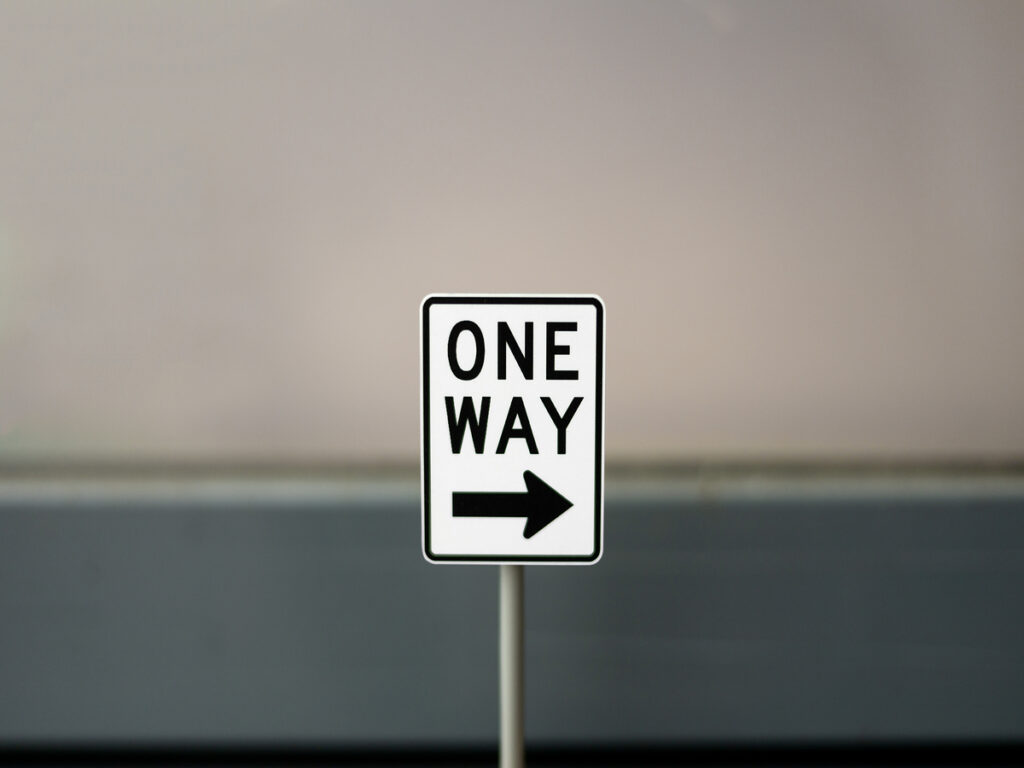
राज्य और शहर अक्सर बदलते हैं कि ट्रैफ़िक संकेत कैसे दिखते हैं. कुछ स्थान बड़े अक्षरों या उज्जवल रंगों का उपयोग करते हैं. अन्य लोग प्रतीकों या अधिक भाषाओं को जोड़ते हैं. उदाहरण के लिए, कैलिफोर्निया स्पेनिश बोलने वालों के लिए दो भाषाओं में संकेतों का उपयोग करता है. टेक्सास देश की सड़कों पर मजबूत रंगों के साथ बड़े संकेत देता है. ये परिवर्तन ड्राइवरों को संकेतों को बेहतर ढंग से देखने और समझने में मदद करते हैं.
| राज्य | अद्वितीय डिजाइन सुविधा | परिवर्तन के लिए कारण |
|---|---|---|
| कैलिफोर्निया | द्विभाषी संकेत | विविध जनसंख्या |
| टेक्सास | बड़ा, उच्च-विपरीत संकेत | ग्रामीण दृश्यता |
| फ्लोरिडा | वाटरप्रूफ सामग्री | बाढ़-वसा क्षेत्र |
| न्यूयॉर्क | अतिरिक्त स्कूल क्षेत्र संकेत | बाल सुरक्षा |
बख्शीश: नए राज्यों में जाने पर ड्राइवरों को इन परिवर्तनों को नोटिस करना चाहिए. स्थानीय नियम बदल सकते हैं कि संकेत कैसे दिखते हैं और उनका क्या मतलब है.
नियुक्ति और उपयोग
MUTCD ट्रैफ़िक संकेतों को कहां डालने के लिए नियम देता है. राज्य मौसम के लिए अपने स्वयं के नियम जोड़ सकते हैं, सड़कें, और यातायात. MUTCD ट्रैफ़िक संकेत एक निश्चित आकार होना चाहिए और सही स्थान पर रखा जाना चाहिए. उदाहरण के लिए, स्टॉप साइन्स कम से कम होना चाहिए 30 अधिकांश सड़कों पर इंच चौड़ा. व्यस्त चौराहों पर, स्टॉप साइन्स होना चाहिए 36 इंच चौड़ा. MUTCD का कहना है कि स्टॉप साइन्स होना चाहिए 2 शहरों में अंकुश से पैर. देश की सड़कों पर, उन्हें होना चाहिए 6 किनारे से पैर.
राज्य सड़क से दूर या धूमिल या बर्फीले स्थानों में बड़े संकेत चाहते हैं. वे घटनाओं या स्थानीय खतरों के लिए अतिरिक्त संकेत जोड़ सकते हैं. ये परिवर्तन ड्राइवरों को विभिन्न स्थानों पर सुरक्षित रखने में मदद करते हैं.
टिप्पणी: राज्यों को MUTCD नियमों का पालन करना चाहिए, लेकिन उन्हें अपनी आवश्यकताओं के लिए सख्त बना सकते हैं.
वैध प्राधिकारी
संघीय कानून देता है हम. परिवहन विभाग और FHWA ने यातायात संकेतों के लिए राष्ट्रीय नियम निर्धारित किए. MUTCD सभी राज्यों के लिए मुख्य मार्गदर्शक है. राज्यों को एक मैनुअल का उपयोग करना चाहिए जो MUTCD नियमों से परे है या जाता है. वे राष्ट्रीय mutcd का उपयोग कर सकते हैं, राज्य नियम जोड़ें, या अपने स्वयं के मैनुअल बनाते हैं जो mutcd से मेल खाता है.
कांग्रेस ने कानून बनाए जो कहते हैं कि संकेतों की तरह की विशेषताएं होनी चाहिए पुनर्मिलन रात के लिए. FHWA जाँच करता है कि क्या राज्य इन नियमों का पालन करते हैं और अपडेट के लिए समय सीमा निर्धारित कर सकते हैं. यदि कोई राज्य नियमों का पालन नहीं करता है, यह सड़कों के लिए संघीय धन खो सकता है. यदि संकेत सुरक्षा नियमों को पूरा नहीं करते हैं तो राज्य भी कानूनी परेशानी का सामना कर सकते हैं, दुर्घटनाओं के बाद मुकदमों की तरह.
चेतावनी: धन और कानूनी समस्याओं से बचने के लिए राज्यों को अपने ट्रैफ़िक साइन नियमों को चालू रखने की आवश्यकता है.
अनुपालन मामले क्यों
वैध निहितार्थ
ट्रैफ़िक साइन नियमों का पालन करना बहुत महत्वपूर्ण है. राज्यों को MUTCD मानकों या अपने स्वयं के अनुमोदित नियमों का उपयोग करना चाहिए. संघीय राजमार्ग प्रशासन अपडेट और चेक के लिए समय सीमा देता है यदि नियमों का पालन किया जाता है. यदि कोई ठेकेदार या एजेंसी इन नियमों का पालन नहीं करती है, समस्याएँ हो सकती हैं:
- एक दुर्घटना होने पर अदालतें उन्हें दोष दे सकती हैं और एक मुकदमा कहता है कि संकेत गायब थे या गलत थे.
- Lawsuits often ask if the sign met MUTCD rules.
- Not following rules can lead to lawsuits for carelessness.
- States can lose federal road money if they ignore MUTCD standards.
- Good engineering judgment matters. Mistakes in picking or placing signs can be used in court.
- The MUTCD is a legal standard. Most enforcement happens through lawsuits, not direct fines.
टिप्पणी: Agencies must follow new MUTCD rule dates. Missing these dates can cause legal and money problems.
सुरक्षा प्रभाव
Good traffic sign rules make roads safer for everyone. Studies show that when signs follow MUTCD and state rules, drivers act better. उदाहरण के लिए:
- Dynamic speed display signs in school zones lower speeds by about 9 मील प्रति घंटा.
- अन्य स्थानों पर, speed drops by 5 मील प्रति घंटे या उससे कम.
- Fast drivers slow down more, कभी -कभी 0.7 को 3 मील प्रति घंटा.
- The chance of tickets makes drivers watch signs more.
- Road type, traffic amount, और साइन विजिबिलिटी बदलें.
ये तथ्य बताते हैं कि अच्छे संकेत क्रैश को रोकने और जीवन को बचाने में मदद करते हैं.
बख्शीश: स्पष्ट संकेत ड्राइवरों को सुरक्षित विकल्प और कम दुर्घटना जोखिम बनाने में मदद करते हैं.
देयता जोखिम
ट्रैफ़िक साइन नियमों का पालन नहीं करने से बड़े जोखिम आते हैं. यदि कोई दुर्घटना होती है और संकेत मानकों को पूरा नहीं करते हैं, बीमा भुगतान नहीं कर सकता है. एजेंसियां या ठेकेदार पैसे खो सकते हैं. मुकदमे कह सकते हैं कि बुरे संकेतों में चोटें या क्षति हुईं. संघीय-सहायता परियोजनाओं को MUTCD अनुपालन की आवश्यकता है, इसलिए लापता मानक फंडिंग को अवरुद्ध कर सकते हैं.
| जोखिम प्रकार | विवरण |
|---|---|
| कानूनी देयता | लापरवाही या बुरे साइनेज के लिए मुकदमे |
| वित्तीय क्षति | बीमा या संघीय सड़क के पैसे का नुकसान |
| प्रतिष्ठा क्षति | दुर्घटनाओं के बाद लोग एजेंसियों पर कम भरोसा कर सकते हैं |
चेतावनी: निम्नलिखित नियम एजेंसियों को मुकदमों से बचने में मदद करते हैं, धन की हानि, और प्रतिष्ठा क्षति.
अनुपालन सुनिश्चित करना
मानकों की पहचान करना
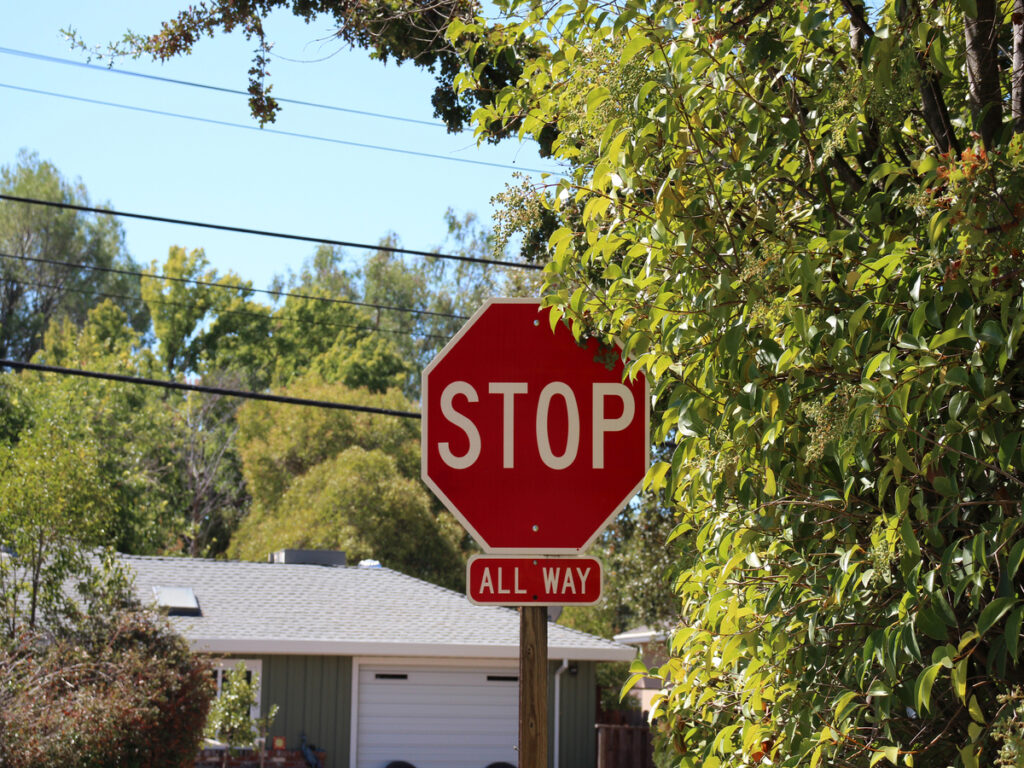
एजेंसियों और ठेकेदारों को पता होना चाहिए कि प्रत्येक परियोजना पर कौन से नियम लागू होते हैं. वे यह पहचानने के लिए इन चरणों का पालन कर सकते हैं कि क्या MUTCD ट्रैफ़िक संकेत या राज्य-विशिष्ट नियम एक संकेत को नियंत्रित करते हैं:
- जांचें कि क्या राज्य अपने मुख्य नियम पुस्तिका के रूप में MUTCD का उपयोग करता है.
- देखें कि क्या राज्य अपने नियमों को जोड़ता है या MUTCD में परिवर्तन करता है.
- किसी भी राज्य की खुराक या विशेष मैनुअल के लिए देखें.
- सुनिश्चित करें कि राज्य परिवर्तन संघीय MUTCD नियमों को नहीं तोड़ते हैं.
- मदद के लिए राज्य परिवहन विभाग या स्थानीय यातायात कार्यालय से संपर्क करें.
सही मानक जानने से टीमों को गलतियों से बचने में मदद मिलती है और सभी के लिए सड़कों को सुरक्षित रखा जाता है.
संघर्षों को हल करना
कभी-कभी, संघीय और राज्य के नियम मेल नहीं खाते. टीमों को दोनों का पालन करने का एक तरीका खोजना होगा. वे कर सकते हैं:
- नियमों को समझने के लिए स्थानीय और राज्य एजेंसियों के साथ काम करें.
- प्रौद्योगिकी का उपयोग करें, स्वचालित निगरानी उपकरण की तरह, ससुराल वालों में बदलाव को ट्रैक करने के लिए.
- समस्याओं को जल्दी से हल करने के लिए विशेषज्ञों के साथ बैठकें आयोजित करें.
स्थानीय नेताओं और राज्य एजेंसियों के बीच सहयोग सभी को एक ही पृष्ठ पर रहने में मदद करता है. यह टीमवर्क सुनिश्चित करता है कि MUTCD ट्रैफ़िक संकेत और स्थानीय संकेत सभी नियमों को पूरा करते हैं.
अद्यतन रहना
ट्रैफ़िक संकेतों के नियम अक्सर बदलते हैं. एजेंसियों को नए कानूनों और सर्वोत्तम प्रथाओं के साथ रखने की आवश्यकता है. वे कर सकते हैं:
- यह जांचने के लिए नियमित रूप से ऑडिट करें कि क्या संकेत नवीनतम नियमों का पालन करते हैं.
- नए मानकों और अद्यतन पर श्रमिकों को प्रशिक्षित करें.
- नियम परिवर्तन के बारे में अलर्ट प्राप्त करने के लिए डिजिटल टूल का उपयोग करें.
- ऑडिट के अच्छे रिकॉर्ड रखें और परिवर्तन पर हस्ताक्षर करें.
- जरूरत पड़ने पर सलाह के लिए विशेषज्ञों से पूछें.
नियमित प्रशिक्षण और ऑडिट टीमों को समस्याओं को जल्दी स्पॉट करने में मदद करते हैं और उन्हें तेजी से ठीक करते हैं.
पेशेवर प्रशिक्षण श्रमिकों को सिखाता है कि कैसे डिजाइन करना है, स्थापित करना, और संकेतों की देखभाल. यह प्रशिक्षण राष्ट्रीय और राज्य दोनों नियमों को शामिल करता है. तकनीकी, डिजिटल संकेतों और वास्तविक समय के अलर्ट की तरह, एजेंसियों को जल्दी से बदलाव का जवाब देने और सड़कों को सुरक्षित रखने में मदद करता है.
सामान्य नुकसान
राज्य के नियमों की अनदेखी
कई एजेंसियां और ठेकेदार केवल MUTCD मानकों पर देखते हैं. वे कभी -कभी याद करते हैं कि राज्यों में अतिरिक्त नियम या परिवर्तन हो सकते हैं. यह गलती ऐसे संकेतों का कारण बन सकती है जो कानून का पालन नहीं करते हैं. इससे कानूनी परेशानी भी हो सकती है. पेंसिल्वेनिया में, छोटे शहरों में प्रशिक्षित इंजीनियर नहीं हो सकते हैं. वे नए नियमों के बारे में नहीं जानते होंगे. वे वक्र सुरक्षा के लिए सड़कों की जांच नहीं कर सकते हैं.
टिप्पणी: शहरों और कस्बों में पर्याप्त पैसा नहीं है जैसे समस्याएं हैं, मुश्किल सड़क के आकार, और एक से अधिक भाषाओं में संकेतों की आवश्यकता है. ये चीजें संघीय और राज्य दोनों नियमों का पालन करना कठिन बना देती हैं.
एक साधारण चेकलिस्ट टीमों को किसी भी संकेत को डालने से पहले MUTCD और राज्य नियमों की जांच करने में मदद करता है.
गलत प्लेसमेंट
गलत जगह पर संकेत डालने से ड्राइवरों को भ्रमित करता है और दुर्घटनाओं का कारण बन सकता है. अध्ययन के बारे में दिखाते हैं 40% गलत तरीके से दुर्घटनाएं होती हैं क्योंकि संकेत स्पष्ट नहीं होते हैं या नहीं सही स्थान पर. कुछ कारण हैं:
- संकेत छिपे हुए हैं या पर्याप्त संकेत नहीं हैं
- संकेत बहुत छोटे हैं या उज्ज्वल नहीं हैं
- इंटरसेक्शन या रैंप को समझना मुश्किल है
- सड़क के निशान फीके या लापता हैं
रात, खराब मौसम, और विचलित ड्राइवर इन समस्याओं को बदतर बनाते हैं. कई लेन या निकास वाली सड़कें लोगों को और भी अधिक भ्रमित कर सकती हैं. ऐसे ड्राइवर जो सतर्क नहीं होते हैं, उन्हें संकेत देखने में कठिन समय होता है. यह गलत तरीके से दुर्घटनाओं को अधिक संभावना बनाता है.
बख्शीश: टीमों को उन संकेतों का उपयोग करना चाहिए जो देखने में आसान हैं, चमकदार, और ड्राइवरों को सुरक्षित रहने में मदद करने के लिए सही जगह पर.
पुराने संकेत
पुराने यातायात संकेत बहुत खतरनाक हो सकते हैं. ड्राइवर पुराने संकेतों को नहीं समझ सकते हैं या बहुत धीरे -धीरे प्रतिक्रिया कर सकते हैं, विशेष रूप से कोहरे में या रात में. यह बदतर दुर्घटनाओं का कारण बन सकता है और लोगों को गलत जगह पर रोक सकता है. नीचे दी गई तालिका कुछ महत्वपूर्ण तथ्य दिखाती है:
| पहलू | साक्ष्य सारांश |
|---|---|
| पुरानी यातायात संकेतों के जोखिम | ड्राइवर अक्सर क्रॉसिंग पर गलत अनुमान लगाते हैं, इसलिए 55% चमकती लाल रोशनी चलाएं; धीमी प्रतिक्रियाएं और बदतर दुर्घटनाएँ, खासकर जब यह देखना मुश्किल है |
| बेहतर संकेतों का प्रभाव | बेहतर संकेत और चिह्नों में ड्राइवरों को संकेत देखने और अधिक बार रुकने में मदद मिलती है |
| प्रासंगिक यातायात संकेतों की आवृत्ति | वहाँ पर हैं 200,000 यू.एस. में ग्रेड क्रॉसिंग, इतने सारे संकेतों को अक्सर जाँच करने की आवश्यकता होती है |
चिन्हों की जाँच और अद्यतन करना अक्सर उन्हें स्पष्ट और देखने में आसान रहता है. प्रशिक्षण और संकेतों की देखभाल करना पुराने संकेतों से दुर्घटनाओं को रोकने में मदद करता है.
MUTCD और राज्य यातायात साइन नियमों को जानने से सभी को सुरक्षित रहने में मदद मिलती है. यह एजेंसियों और ठेकेदारों को कानूनी परेशानी में पड़ने से बचने में भी मदद करता है. नियमित चेक और शिक्षण श्रमिकों को जनता के साथ विश्वास का निर्माण करता है. विशेषज्ञों के साथ काम करना सुनिश्चित करता है कि हर कोई नियमों का पालन करता है.
- एजेंसियों को रात में चमकने वाले संकेतों का उपयोग करने की आवश्यकता है. उन्हें आसानी से पढ़े जाने वाले फोंट चुनने चाहिए. संकेतों को सही स्थान पर रखा जाना चाहिए.
- LCPtracker और Veriforce जैसी सेवाएं निम्नलिखित नियमों और शिक्षण श्रमिकों के लिए उपकरण देती हैं.
| संसाधन | महत्वपूर्ण कार्यों |
|---|---|
| Lcptracker | नियम-निम्नलिखित और रिपोर्ट को ट्रैक करने में मदद करता है |
| चेक आउट | जोखिम संभालता है, यह सिखाती है, और श्रमिकों की जांच करता है |
एक अनुपालन विशेषज्ञ से पूछें या ट्रैफ़िक साइन प्रोजेक्ट्स को सुरक्षित और कानूनी बनाने में मदद करने के लिए गाइड का उपयोग करें.
अक्सर पूछे जाने वाले प्रश्न
Mutcd क्या है?
MUTCD एक समान ट्रैफ़िक नियंत्रण उपकरणों पर मैनुअल के लिए खड़ा है. यह संयुक्त राज्य अमेरिका में यातायात संकेतों के लिए नियम निर्धारित करता है. हर राज्य ड्राइवरों और वॉकर को सुरक्षित रहने में मदद करने के लिए इसका उपयोग करता है.
कुछ राज्य MUTCD नियम क्यों बदलते हैं?
राज्य स्थानीय जरूरतों को पूरा करने के लिए MUTCD नियम बदलते हैं. मौसम, भाषा, और सड़क प्रकार राज्यों को बड़े संकेतों का उपयोग कर सकते हैं, उज्जवल रंग, या अधिक भाषाएँ.
यदि कोई संकेत राज्य के नियमों का पालन करता है तो कोई कैसे जांच सकता है?
एक व्यक्ति परिवहन विभाग से संपर्क कर सकता है. वे राज्य के ट्रैफ़िक साइन मैनुअल को भी देख सकते हैं या मदद के लिए स्थानीय ट्रैफ़िक कार्यालयों से पूछ सकते हैं.
यदि कोई संकेत MUTCD या राज्य मानकों को पूरा नहीं करता है तो क्या होता है?
एजेंसियों को मुकदमों का सामना करना पड़ सकता है या संघीय सड़क के पैसे खो सकते हैं. ड्राइवर भ्रमित हो सकते हैं, और दुर्घटनाएँ हो सकती हैं. संकेतों को अद्यतित रखने से सभी को सुरक्षित रहने में मदद मिलती है.

